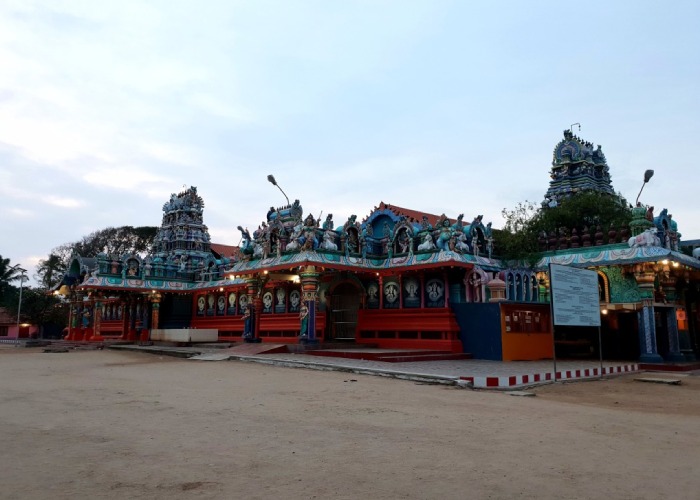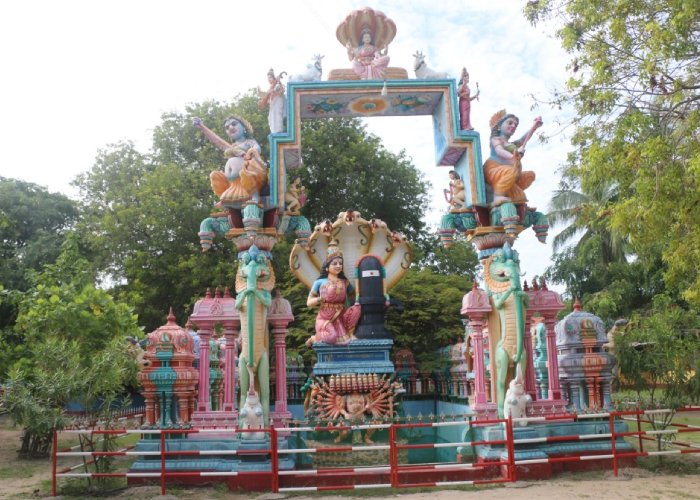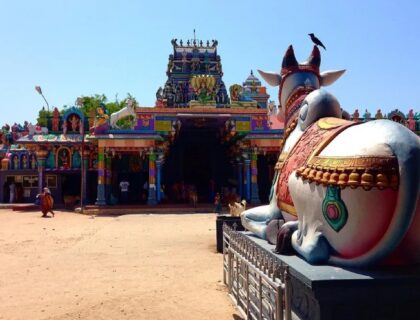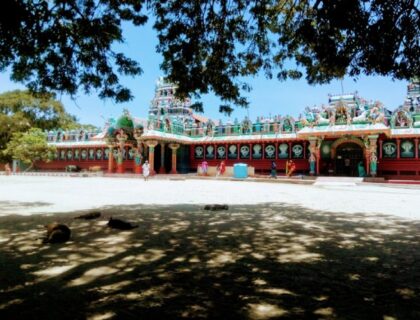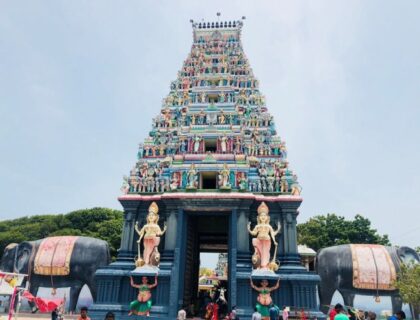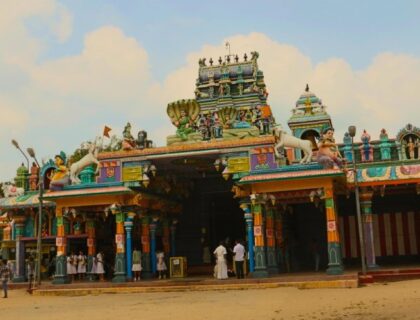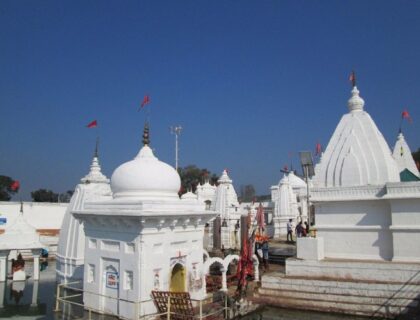Nainativu Nagapooshani Shaktipeeth
Nainativu Nagapooshani Amman Temple is an ancient and historic Hindu temple located 36 km from the ancient capital of the Jaffna kingdom, Nallur, Sri Lanka. It is dedicated to Parvati who is known as Nagapooshani or Bhuvaneswari and her consort, Shiva who is named here as Rakshaseshwar (Nayanair).
The temple complex houses four gopurams (gateway towers) ranging from 20–25 feet in height the tallest being the eastern Raja Raja Gopuram soaring at 108 feet high. Adi Shankaracharya, a 9th-century Hindu philosopher, is credited with identifying the temple as one of the major 64 Shakti Peethams in Shakti Peetha Stotram and mentioning it in the Brahmanda Purana.
Story Behind Nainativu Nagapooshani Shaktipeeth
The goddess of Dakshayani, Sati, Parvati, or Durga—Hinduism’s most important woman and most powerful deity—is called Shakti. Durga Devi, Mahakali, and Gowri are the three main manifestations of Shakti, the power goddess. She is Adi Shakti’s avatar.
Sati was the Prajapati Daksha’s daughter, and she married Lord Shiva despite Her father’s wishes. Prajapati Daksha once put together a massive yagya, but he didn’t call his daughter and son-in-law. Sati was very saddened by Her father’s actions. When she got there, her father ignored the Sati and insulted her. She could not bear the insult of his husband (Lord Shiva) and she jumped into the fire of Yagya and committed suicide. She passed away, but her body didn’t burn. Lord Shiva had taken His Virabhadra Rupa out of rage. Daksha’s head was cut off by him, but in the end, He forgave him by bringing him back to life.

Lord Shiva, devastated, had taken Sati’s body and wandered the universe. Finally, Lord Vishnu used His Chakra to break Sati’s body into pieces. Each body part transformed into Shakti Pitha. The temple had emerged where the body part had fallen to the ground. In order to safeguard the Shakti Pitha, Lord Shiva created 51 Bhairava for each one.
It is thought to be the location where Gauri’s silambu (anklets) fell. Since time immemorial, anklets have held great significance in Shakti worship. This item is also mentioned in the well-known Tamil epic Silapathikaram, where the story starts and finishes with an anklet.
History of Nainativu Nagapooshani Shaktipeeth
Nainativu Nagapooshani complex has four gopurams (gateway towers) varying in height from 20 to 25 feet, with the eastern Raja Raja Gopuram standing at 108 feet. The temple is a major icon for the Tamil people, and it has been described in Tamil literature since antiquity in works such as Manimekalai and Kundalakesi.

After the ancient structure was demolished by the Portuguese in 1620, the current structure was erected between 1720 and 1790. The temple receives roughly 1000 people each day, with up to 5000 tourists during festivals. Over 100,000 pilgrims attend the annual 16-day Mahostavam (Thiruvizha) festival held during the Tamil month of Aani (June/July). This recently refurbished temple contains an estimated 10,000 sculptures.
The architecture of Nainativu Nagapooshani Shaktipeeth
Nainativu Nagapooshani Shaktipeeth includes four bright and ornate gopurams. The Raja Raja Gopuram is the largest of the temple’s three gopurams. The East Gopuram is the most ancient of the three gopurams on the current construction. It opens to the east, facing the rising sun across the sea. South Gopuram was constructed in the early 1970s. It opens to the south. From the ground, it rises to a height of 54 feet. Sculptures on this gopuram were also painted in brighter colours during the remodelling phase to complement the newly erected Raja Raja Gopuram.

Nainativu Nagapooshani moolasthanam or garbhagriha (“womb chamber”, primary shrine) and her consort Nayinar Swami (Shiva) are built in the typical Dravidian Hindu style. The inner wall of the temple and the outer wall of the central shrine form a pradakshina (path) that circles the garbhagriha. The foyer is lavishly furnished with paintings, sculptures, and oil lights. A 10-foot-tall vimana (tower) towers over the garbhagriha. The garbhagriha has two entrances: one facing East, where the Moolamurtis (consecrated deities) can be seen, and one facing South, where the Utsavamurtis (festival deities) can be seen.
Facts about Nainativu Nagapooshani Shaktipeeth
- Nainativu Nagapooshani Amman Temple is an ancient and historic Hindu temple located 36 km from the ancient capital of the Jaffna kingdom, Nallur, Sri Lanka.
- It is dedicated to Parvati who is known as Nagapooshani or Bhuvaneswari and her consort, Shiva who is named here as Rakshaseshwar (Nayanair).
- The temple is a significant symbol for the Tamil people and has been mentioned since antiquity in Tamil literature, such as Manimekalai and Kundalakesi.
- Bhuvaneshwari means the Queen or ruler of the Universe. She is the Divine Mother as the Queen of all the worlds.
- She is also known as Adi Shakti i.e. one of the earliest forms of shakti. She is capable of turning situations according to her wish.
- The present structure was built from 1720 to 1790 after the ancient structure was destroyed by the Portuguese in 1620.
- The Nainativu Nagapooshani Temple is believed to have been originally established by the god Indra while seeking alleviation from the curse of the sage Gautama.
- Ganesha (Ganapathi), Bhuvaneswari, Kartikeya (Subrahmanya) with consorts Valli and Devayani, Navagraha, Surya, Chandra, Bhairava, 63 Nayanars, Nalvars, and Chandikeswarari are also present in the temple.
- The temple is also significant because it is believed to be one of the places where Lord Parasurama set foot on Earth.
Festivals In Nainativu Nagapooshani Shaktipeeth
- Durga Puja. (Winter) – Devotees celebrate Navaratri at this temple in the month of Ashwin (Sep-Oct).
- Navaratri. (Summer) – They celebrate other Navaratri in the fortnight of the Chaitra (March-April). Every nine days they worship Navadurga (nine Durgas).
- Diwali – Diwali is one of the most admired and auspicious festivals in the town.
- Mahashivratri– A grand fair is organized at the temple during the occasion of Maha Shivratri.
- The most important festival associated with the temple is the 16-day-long Mahostavam (Thiruvizha) which is celebrated annually in the Tamil month of Aani (June/July).
How to Reach Nainativu Nagapooshani Shaktipeeth
Nainativu Nagapooshani Amman Temple is an ancient and historic Hindu temple located 36 km from the ancient capital of the Jaffna kingdom, Nallur, Sri Lanka.
By Air: Jaffna airport is 52.7 Km From the temple.
By Railway: Jaffna Railway Station is 36 km from the temple.
By Roadways: The Temple is located about 28 Km from Kayts and 35 Km from Jaffna Bus Stand. Devotees can take any local bus heading to Kurikaadduvaan from Jaffna (Route 776), and then they have to take a short ferry to Nainativu Island. The bus trip from Jaffna to Kurikaadduvaan would take approximately one hour.
Read Also – Guhyeshwari Shaktipeeth
Location
Facilities
- Drinking Water
- Pooja Item Shops
- Prasad Shops
- Restaurants Nearby
- Resting Room






